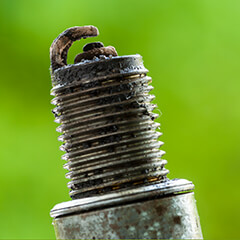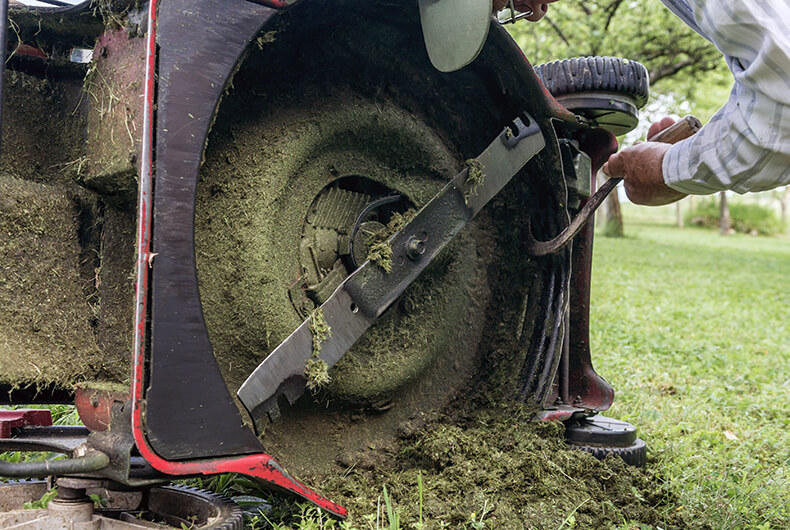
Spring mowing season is coming soon, and with it comes lush, beautiful grass that needs cutting. Unfortunately, your lawnmower has been sitting in your garage all winter long. As a result, it will require a tune-up before it’s in condition to mow.
You can take it to a small engine shop if you don’t want to fool with it, but it’s not hard at all to complete these mower maintenance tasks by yourself. Plus, it will save you money and the aggravation of loading it up and hauling it over town. Keeping your mower’s blades, spark plugs and other equipment maintained will help prevent costly lawn mower breakdowns.
These are my top 7 lawn mower maintenance tips to get you ready for spring and allow your mower to run smooth:
Table of Contents
Spring Lawn Mower Maintenance Checklist
1. Change the oil
Dirt and debris in your oil will mess up your engine big time. So now is an excellent time to change it. I recommend doing this once per season and checking the oil level throughout spring and summer.
If your mower has a drain plug, you have it easy. Just let it drain into a recycling pan and turn it into a recycler when it’s full.
However, some mowers do not have a drain plug, and you will need to carefully tilt the mower on its side to allow the oil to drain.
Top it off with the lawn mower oil recommended in your user’s manual. Check the manufacturer’s website if you have misplaced your user’s manual (it happens!). They will usually have a pdf copy for free.
For example here is Honda’s lawn mower manual site.
2. Replace the air filter
If you’ve been following my advice, you have been cleaning the mower air filter before each use. However, it’s a good idea to go ahead and replace it every year.
Check your manual for the correct replacement model or find the number on the filter you are removing.
It’s a good idea to write these numbers down and put them in a drawer somewhere. If you want to get high-tech, you can use Evernote or Google Keep. I put all the little bits of info about the house (filter sizes, bulbs, etc.) there. It’s handy to pull it up on your phone when you need it.
If you take care of your mower, it will last for 10-15 years or more. That sheet will come in handy.
3. Clean or replace the spark plugs
 Dirty plugs will cause backfires and slow starting. Not to mention using up more gas while you cut.
Dirty plugs will cause backfires and slow starting. Not to mention using up more gas while you cut.
I don’t replace mine every year. The spark plugs seem to work fine with yearly cleaning.
Disconnect the spark plug cap and find a socket or wrench that will fit. Then, unscrew the plug and take a look at it.
If there is a build-up of carbon and soot on the tip, you can use some fine sandpaper to clean it off. Be careful not to pull out the lead and make the gap larger than it is.
Lawn mower spark plugs are inexpensive if you want to replace them, so buy a couple the next time you are in Home Depot or on Amazon. That should last you for years.
4. The best way to sharpen lawn mower blades
This step is so important it should have been number 1. A dull blade will make grass cutting feel like a chore. Get it? Hah!
Blade sharpening might be the most challenging part of lawn mower maintenance, but everyone can do it.
You’ll want to do this when your gas tank isn’t slam-full as you need to turn the mower on its side to get at the blades. You can also tilt it back so it rests on its handle, but you’ll probably need to get someone heavy to hold it in place or have another set of hands.
Keep a mental note of the way the blades are facing when you take them off. We don’t want to put them on backward when reattaching them!
Get a big, sturdy socket wrench and unscrew the bolt. It might be on there pretty tight.
To sharpen the blade(s), you’ll need to keep them sturdy while you hone them. The best way is to put them in your workbench vise. You can still sharpen them if you don’t have one by holding the blades between your legs. You are wearing work pants, right?
Get ready to work out.
Push your rasp or file in the same direction each time. You’ll want to push it from the center of the blade outwards to the edge. Do this up and down the blade’s length until the side is razor-sharp.
I do the other side, even though I’m not too sure it matters.
Be sure not to push and pull the file on the blade. Just one direction.
5. Change out the fuel
Gasoline that isn’t in a sealed container can go bad. Sounds weird, I know.
At the time of refining, it is a perfect mixture to burn. However, having the gas sit in your lawn mower’s tank for six months can cause some of those chemicals to evaporate and change the formula.
Your best bet is to run the mower dry at the end of each season. If you didn’t, you’d need to siphon the old gas out and recycle it along with your old oil. A lot of counties have recycling centers that will take these items.
Top off the tank with fresh gas, and you’ll be good to go.
6. Tighten the bolts
Now is an excellent time to check all the bolts and tighten them up.
First, check the blade. You don’t want that coming off while you’re cutting. Also, check the wheel bolts and tighten them where needed.
Another area you can double-check is where the bolts hold the engine block to the frame. These will be in a circle above the blade. If you have a self-propelled lawn mower, be sure to hit the bolts on the drive, depending on your model, it could be in the front or rear.
Check your kill switch too. The kill switch is the lever that must be held in place to start the mower. If it doesn’t work and your mower keeps running after releasing it, pull the spark plug until you can replace it.
7. Examine the undercarriage
 Remember all those times your grass was too wet to cut but you did it anyway? All those clumps are stuck to the bottom of your mowing deck and block the proper operation of your mower.
Remember all those times your grass was too wet to cut but you did it anyway? All those clumps are stuck to the bottom of your mowing deck and block the proper operation of your mower.
I use a large flat blade screwdriver to scrape off the large chunks of grass and then come back with a metal wire brush. Clearing all this junk away should help your mower not choke when cutting thick grass.
A bucket of soapy water can get the rest of your mower looking ready for work. Be sure to rinse it cleanly and avoid getting any debris or grass in the gas tank while cleaning.
—-
I hope these tips help you out this spring. If you put just a little effort into maintaining your lawnmower (including your riding lawn mower) and other lawn equipment, it will serve you well for many years.
This project isn’t complex and should take you no more than an hour or a little more.
With your mower running right, you can be sure to have a perfect-looking lawn this year.
Pinterest Image:



